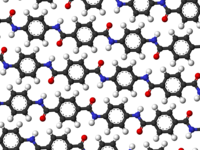
Photo from wikipedia
Materials composed of a polymer matrix reinforced with carbon/glass fibres providing lightweight and superior mechanical properties are widely used as structural components for automotive and aerospace applications. However, such parts… Click to show full abstract
Materials composed of a polymer matrix reinforced with carbon/glass fibres providing lightweight and superior mechanical properties are widely used as structural components for automotive and aerospace applications. However, such parts need to be joined with various metal alloys to obtain better mechanical performance in many structural elements. Many studies have reported enhancements in polymer–metal bonding using adhesives, adhesive/rivet combined joints, and different surface treatments. This study investigated the influences of various surface treatments on the adhesion between glass-reinforced poly(phenylene) sulphide (PPS) and aluminium alloy during the injection over-moulding process. Adhesion strength was evaluated via the shear test. Correlations for the shear strength of the polymer–metal with different metal–substrate treatments were studied. Since the strongest bonding was attained in the treatment with the highest roughness, this value, as it determines the level of micromechanical interlocking of connected materials, seems to be a critical factor affecting the adhesion strength. Three-dimensional (3D) topographic images characterized with a 3D optical microscope indicated that there was a meaningful influence exerted by the interface topologies of the aluminium substrates used for the over-moulding process. The results further indicated that increases in a substrate’s surface energy in connection with atmospheric plasma treatments negatively influence the final level of the bonding mechanism.
Journal Title: Materials
Year Published: 2022
Link to full text (if available)
Share on Social Media: Sign Up to like & get
recommendations!